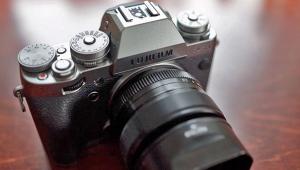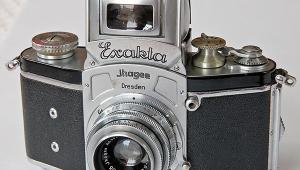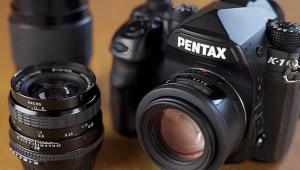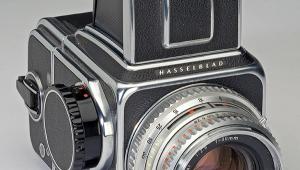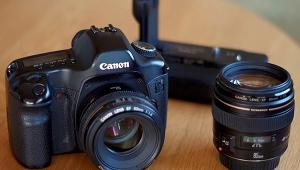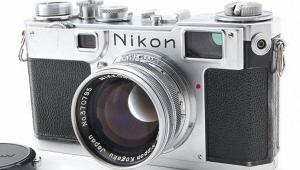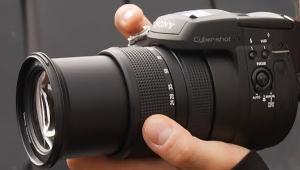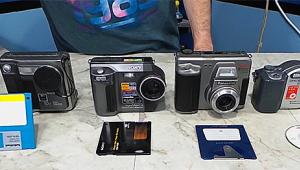A Camera Collector’s Shelf: A Tribute Via An Array Of Press Cameras
On the shelf in my home office I have a collection of press cameras I’ve never used to take a picture. That’s not what they’re there for. They’re a tribute to a generation of bygone news photographers whose professionalism and skill set a standard to which I’ve aspired for over 40 years.

* The rare Lang Jet Flash that used C-cells rather than the usual D-cells
* 2 1/4x3 1/4 Zeiss Nettel, ca. 1930
* 2 1/4x3 1/4 British Van Neck, ca. 1938
* 3 1/4x4 1/4 1940 Anniversary Speed Graphic with 10” Wollensak Tele-Raptar (note correct viewfinder mask)
MAIN SHELF:
* Strobo-Research Teleflash—designed by Edward Farber in 1948, the only flashbulb slave ever made
* 2 1/4x3 1/4 1947 Pacemaker Speed Graphic—note Graflite Junior flash using internal sync and infrared flashbulb
* 4x5 1945 Meridian press/view—“The American Linhof”
* 3 1/4x4 1/4 1948 Kalart Press Camera—it featured a simple-minded “Electric Brain” to prevent double exposures and blanks using dedicated film holders
* Mendelsohn Speed Gun Model C, mid 1930s—it was later marketed as the Kodak Senior Synchronizer
* Beseler 4x5 Press Camera, ca. 1955—very advanced for its day with viewfinder/rangefinder adaptable to three lenses (90mm, 135mm, 240mm) with Heiland three-reflector flashgun. The resulting outfit is almost too heavy to hand hold!
* Desktop sculpture of press camera with all details correct—very neat!
BEHIND BESELER CAMERA—three 5x7 single-plate holders for the Devin One-Shot Color Camera, ca. 1938
* 3 1/4x4 1/4 Speed Graphic, ca. 1930, with 135mm Tessar and Kalart Micromatic Speed Flash
* Another Strobo-Research Teleflash
* 4x5 1948 Burke & James Press Camera with Heiland flashgun
* 3 1/4x4 1/4 1939 National Photocolor one-shot color camera (the gem of my collection) with range- and viewfinder for “action” shooting
* “Top handle” 4x5 Speed Graphic with barrel-mounter 150mm Tessar lens, ca. 1920
* 1946 Graphic “45,” a civilian model of the Combat Graphic camera of April, 1945; 127mm Ektar lens with front-cell focusing
* 2 1/4x3 1/4 Busch Pressman, ca. 1950, with “Contax Style” viewfinder-rangefinder and Heiland “D-Pack” Strobonar of 1955
I didn’t know it then, but I was one of a transitional generation of photographers when I went to work for Associated Press New York in the 1960s. I encountered a cadre of (all-male) colleagues anywhere from 20 to 40 years older than me, guys who’d been hired in the ’30s or ’40s and to whom Speed Graphics or Big Bertha Graflexes had been old and familiar friends. Naturally, I saw myself as the new, “creative” breed who’d greatly improve on their sheet-film thinking (although by then they all used Nikons). What did these guys in the cheap suits do that I couldn’t do better?
Plenty, as I quickly discovered.
These men of whom I started out feeling so contemptuous had far more talent than I realized and I learned almost immediately not to underestimate them. A classic example was editing their film—the last picture they shot on the roll of Tri-X was always exactly right, they knew it, and didn’t take any more. My crowd just shot and shot but those 4x5-trained guys knew when they had the picture and stopped right there, a skill they’d earned in the days when taking more than one picture was a lot more trouble. Where I’d once sneered at these “reactionaries” I began envying their self-control and professionalism.
And what professionalism! They never got a caption wrong or wasted film. I can still feel the thrill I got editing the 70mm Tri-X photographer Marty Lederhandler—or John Rooney, or Harry Harris—who had just shot at Yankee Stadium with a rapid-sequence Hulcher camera and a 640mm lens. Marty never missed and every pre-focused picture was tack-sharp and perfectly timed…even at 20 frames per second he never needed more than five to catch the action. Marty’s years with a 5x7 Big Bertha and a 28” lens had served him so well that using the clumsy Hulcher was child’s play. Could I match that? Not in a million years.
These guys came from a world totally unlike my own—the working class professional to whom art and culture meant nothing. It was a job to them, but a job they did with pride and skill honed by decades of experience. I doubt any of them took a single picture after they retired, but no matter; when called on they always delivered.
True, I couldn’t talk to them about feminism, civil rights, sex, or liberal politics, but that wasn’t as important as I thought it would be once I understood they were kind, contented people who respected and praised my own efforts. “I’ve been looking at your work lately!” Charley “Reindeer” Carey used to say to me when I moved on to The Boston Globe, adding “TERRIFIC!” It was hyperbole, but his affection was obvious. Oh, how I miss the Reindeer now!
So keeping a shelf of bygone press cameras seems like a modest expression of gratitude for the photographers I first despised but wound up loving, people I’ll always miss, who set standards I take seriously to this day. The pictures they took with cameras like this called for abilities and attitudes I can only dream of having.
Thank you guys…so very, very much.
